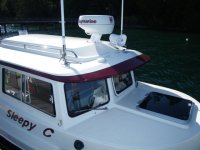I finally did it and found the perfect size panels for our roof. But I had to import them from the UK to avoid paying way too much for them. This is where I plan to put them, one on each side.
http://www.c-brats.com/modules.php?full ... _photo.php
They are a thin flexible panel and the recommended adhesive for roof attachment is generically Sikaflex. There are of course different formulas of that product with this being a common example.
http://www.jamestowndistributors.com/us ... kaflex+291
What type of roof surface prep would you recommend and what type of adhesive solution would you pursue if this was your boat?
I am thinking:
-Clean the roof surface well
-Use a bead of 3M 4000UV or just use 3M VHB double sided tape
Thoughts?
Greg
http://www.c-brats.com/modules.php?full ... _photo.php
They are a thin flexible panel and the recommended adhesive for roof attachment is generically Sikaflex. There are of course different formulas of that product with this being a common example.
http://www.jamestowndistributors.com/us ... kaflex+291
What type of roof surface prep would you recommend and what type of adhesive solution would you pursue if this was your boat?
I am thinking:
-Clean the roof surface well
-Use a bead of 3M 4000UV or just use 3M VHB double sided tape
Thoughts?
Greg

